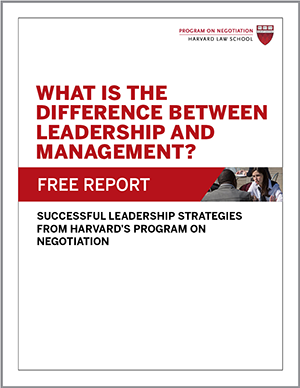
When we think of successful leaders, we typically envision a solitary person—a president, CEO, or entrepreneur—drawing on their vision, charisma, and drive to inspire and direct others. As our world grows increasingly more connected and complex, however, this top-down approach to leadership is becoming increasingly outdated. More and more, organizations are replacing charismatic leadership by a single person with new models of collective leadership.
What Is Collective Leadership?
In collective leadership, a group of people with diverse skills and experience come together to work toward goals that they develop jointly. As compared to traditional leadership, in which one person makes key decisions after consulting with others, in collective leadership, the group empowers the person or people with the most relevant expertise to tackle particular problems and implement solutions. When needed, the group engages in consensus building or conflict resolution to reach decisions and resolve any disputes that arise.
“Multiple individuals within the team may serve as leaders in both formal and informal capacities,” explain Tamara L. Friedrich of the University of Oklahoma and her colleagues in an article on collective leadership in the Leadership Quarterly, “and the shifting of leadership responsibilities is often rooted in which individual’s expertise is most relevant to the given problem.”
Thus, this type of leadership is a social process rather than a series of top-down directives. To succeed, it requires “trust, shared power, transparent and effective communication, accountability, and shared learning,” write Cassandra O’Neill and Monica Brinkerhoff in Nonprofit Quarterly.
Principles of collective leadership are rooted in organizational theorist Mary Parker Follett’s 1924 concept of “the law of the situation,” which advised people to follow the person with the most knowledge of the situation at hand rather than the official authority. “Collective leadership is based on the assumption that everyone can and should lead,” write O’Neill and Brinkerhoff. After all, in the real world, the knowledge needed to solve complex problems rarely can be found in one individual.
When Costa Rican diplomat Christiana Figueres visited the Program on Negotiation to receive its 2022 Great Negotiator Award for her work spearheading the 2015 Paris Agreement on climate change, she said in an interview that collective leadership had served the talks well. Because “the challenges that we face are so complex,” Figueres said, the world is moving in the direction of collective leadership.
Benefits of Collective Leadership
“In collective leadership, there is shared responsibility and decision making, accountability, and authentic engagement,” write O’Neill and Brinkerhoff. As a result, collective leadership can enable organizations to “break down functional silos, integrate global offerings, and work closely with multiple stakeholders,” write University of Mississippi professor Kristin L. Cullen-Lester and her colleagues in an Industrial and Organizational Psychology article.
Because this type of leadership requires collaboration and broad buy-in, it can be expected to generate more stable solutions than decisions made by a single top leader. Collective leadership also avoids the disruption that organizations face when their top executive moves on.
Unlike more autocratic leadership structures, collective leadership assumes skilled individuals are capable of doing their work without constant supervision. By empowering workers to complete assignments on their own—rather than micromanaging them—collective leadership can increase workers’ intrinsic motivation and deepen their job satisfaction.
“Collective leadership recognizes that lasting success is not possible without diverse perspectives and contributions,” write O’Neill and Brinkerhoff. As such, organizations that aim to be more diverse, equitable, and inclusive might see particular value in collective leadership. By making leadership less hierarchical, a collective leadership structure should give women, people of color, and other frequently marginalized stakeholders a greater voice in leadership decision-making. Leaders will have greater incentives to take many perspectives and experiences into account.
Collective Leadership in Action
Collective leadership need not entirely eliminate the role of a primary leader; rather, it can allow “leadership to shift according to expertise and task, and move between team members as the collectivistic process changes,” write Salisbury University professor Jill Caviglia-Harris and her colleagues. The lines between leaders and followers are less clearly defined in collective leadership than they are in hierarchical leadership.
As a case study of effective collective leadership, the researchers describe how an interdisciplinary team of scientists, extension specialists, and practitioners worked with farmers in the U.S. Corn Belt to develop and introduce a novel conservation practice, prairie strips. Team members collaborated on designs that would integrate small amounts of wild prairie among corn and soybean crops to improve soil, water, and biodiversity. Farmers determined for themselves the best design for their farm and implemented the prairie strips with government funding.
The collective leadership process has become the largest private land conservation program in the United States. “Crucial to this process was the recognition of farmers as professionals and as the experts on their farms,” write Caviglia-Harris and her team. The researchers survey farmers annually to solicit their feedback and knowledge, and share the data they collect on the farms with the farmers as well.
How well have initiatives worked in your organization or industry?





It appears that collective leadership works largely in social sector , where stakes are evenly spread out. Will it work in a commercial enterprise where stakes are high and is skewed within a few narrow sect of people at the top who are accountable to the shareholders?